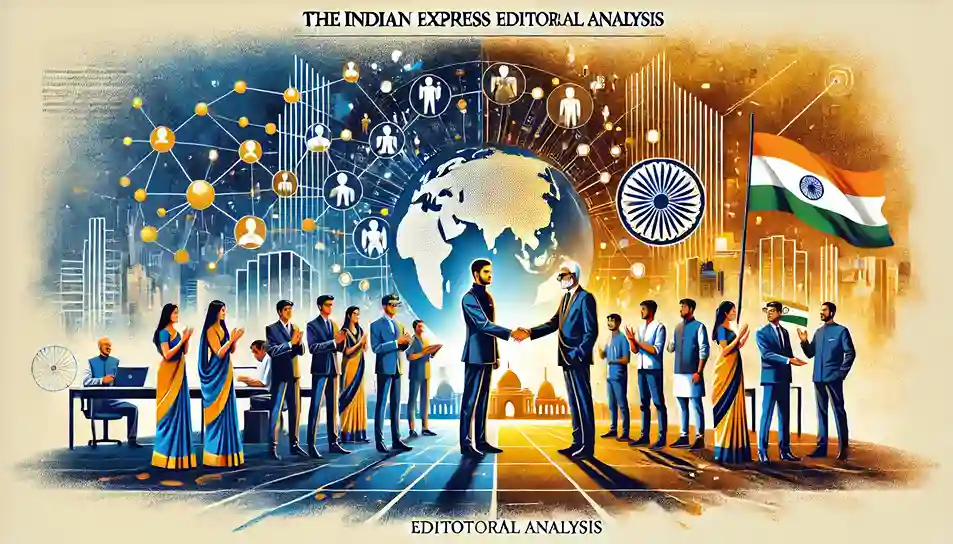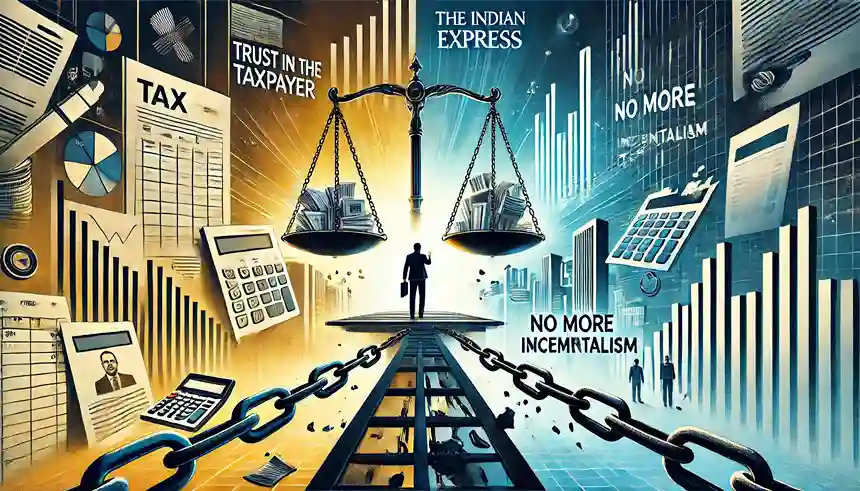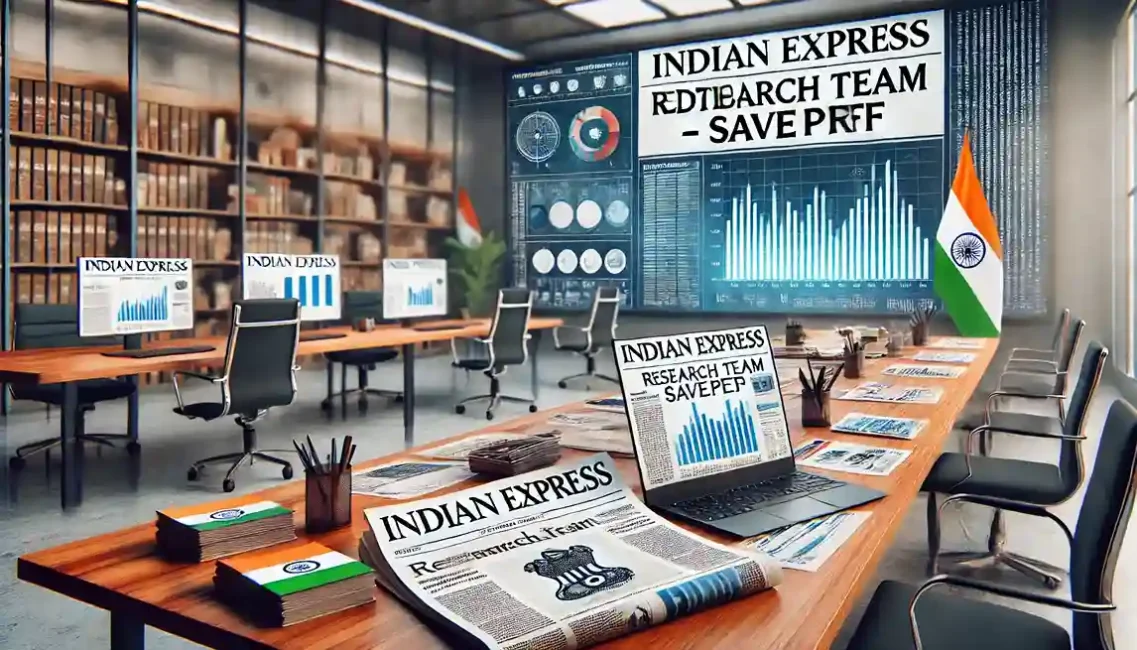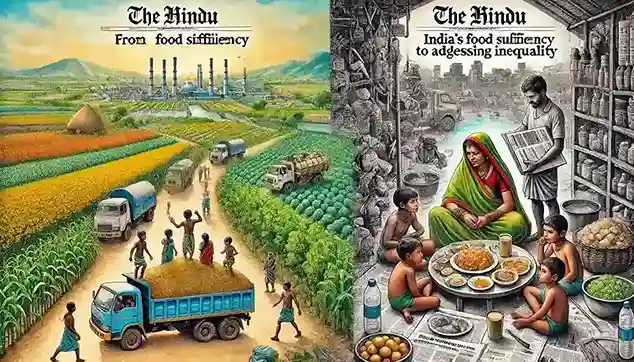Analysis of The Hindu Editorial 1: A food-sufficient India needs to be hunger-free too
Context
India has made significant strides in becoming food-sufficient, yet a critical challenge remains: ensuring that all citizens have access to healthy, affordable diets. The need for a transformation in India’s agri-food system is evident, focusing on accessibility and affordability to combat hunger, malnutrition, and food insecurity.
Introduction
One of the key Sustainable Development Goals (SDGs) is to eliminate hunger and all forms of malnutrition by 2030. Unfortunately, this objective seems distant, largely due to factors like ongoing conflicts, climate-related disruptions, and economic slowdowns that exacerbate food insecurity. Achieving food security isn’t just about producing enough food—it’s about ensuring a balanced and nutritious diet is within reach for everyone.
- Food insecurity and malnutrition arise from inadequate access to affordable, nutritious food.
- Food sufficiency, while crucial, does not automatically ensure equitable distribution or nutritional adequacy.
- Balanced nutrition is essential, as merely consuming enough calories doesn’t address malnutrition caused by nutrient deficiencies.
- Transformation needed: India must shift from merely being hunger-free to becoming nutritionally secure, ensuring that healthy diets are both affordable and accessible across all population segments.
- Analysis of The Indian Express Editorial – February 13, 2025

- Analysis of The Indian Express Editorial – February 12, 2025

- Analysis of The Indian Express Editorial – December 31, 2024

- Analysis of The Indian Express Editorial – December 19, 2024

- Analysis of The Indian Express Editorial – December 18, 2024

Affordability and Access to Food
A major barrier to eradicating hunger and malnutrition is the lack of purchasing power among vulnerable populations. Global assessments indicate that progress towards ending hunger has been sluggish.
- Global hunger statistics show that as of 2023, 757 million people—or 9.4% of the global population—are undernourished.
- Hunger is most severe in Africa, where 20.4% of the population is affected.
- In Asia, 8.1% of people are undernourished, which equates to 384.5 million individuals—making it the region with the largest absolute number of hungry people.
- Projections for 2030 suggest that half of the world’s undernourished population will reside in Africa, highlighting the regional disparities in food security.
- Rural-urban divide: Hunger is more prevalent in rural areas, while urban and semi-urban populations experience a slight advantage.
- Gender disparities: Women continue to be disproportionately affected by hunger, though the gender gap is narrowing.
The Role of Purchasing Power in Food Security
Undernourishment and hunger are often the result of inadequate purchasing power, making the cost of a healthy diet (CoHD) a significant factor in food security.
- The average cost of a healthy diet globally reached $3.96 per person per day in 2022, with regional variations—$4.20 in Asia.
- Despite the rising cost, the global number of people unable to afford a healthy diet decreased slightly from 2.88 billion in 2021 to 2.83 billion in 2022. However, many low-income countries still struggle to make healthy food accessible, posing a serious threat to achieving zero hunger by 2030.
Addressing Hunger Through Policy
A sustainable solution to hunger involves regulating food prices and reducing the proportion of income spent on food, making healthy diets universally affordable. In India, the concept of “Thalinomics”—tracking the affordability of a nutritionally balanced meal—highlights the need for interventions that make nutritious diets accessible for all.
Indian Food Security: A Closer Look (2011 Data)
An analysis of India’s food security shows that a significant portion of the rural population lacks access to an adequate diet. In 2011, 63.3% of the rural population (527.4 million people) couldn’t afford a nutritious diet even if they spent their entire income on food. This underscores the deep inequality in access to food, necessitating a transformation in India’s agri-food system to build resilience and reduce disparities.
Unhealthy Dietary Patterns in India
India faces a dual challenge of hunger and unhealthy diets. Many diets are nutritionally imbalanced when compared to the EAT-Lancet reference or the Indian Council of Medical Research’s recommendations.
- A significant portion of the Indian population, particularly in low-income groups, cannot afford healthy diets, which can consume up to 60% of daily household income in South Asia.
- The wealthiest 5% of Indian households, despite having higher incomes, often consume less nutritious, protein-rich foods in favor of processed foods, suggesting that awareness, availability, and acceptability are as crucial as affordability in shaping dietary choices.
Global Hunger Index (GHI) and India’s Position
India’s ranking on the Global Hunger Index (GHI) has sparked controversy. While the GHI focuses on nutrition and child mortality, critics argue that it does not fully capture the reality of hunger in India.
- National surveys offer a clearer picture: According to the NSSO’s consumption expenditure surveys, 3.2% of India’s population does not meet the minimum requirement of 60 meals a month. While 50% of the population consumes three meals a day, an estimated 2.5% of the population struggles to have two square meals daily—a figure that translates to 35 million people.
Conclusion: Toward a Hunger-Free India
As the world observes World Food Day with the theme “Right to Food for a Better Life and a Better Future,” it’s clear that India has much work to do. Despite its status as a food-sufficient nation, there are still gaps in ensuring that no one goes hungry.
Solutions like food banks and efforts to prevent food waste could help bridge the gap between food sufficiency and hunger-free status. India must continue to work toward ensuring that every citizen has access to affordable, nutritious food, recognizing that true food security means not just enough food, but the right kind of food for a healthy and dignified life.
Table: Key Statistics on Global and Indian Hunger
| Metric | Global | India |
|---|---|---|
| Global Hunger Rate (2023) | 9.4% (757 million undernourished) | 8.1% in Asia (384.5 million) |
| Hunger in Africa | 20.4% | N/A |
| Hunger in Rural India (2011) | N/A | 63.3% couldn’t afford a healthy diet |
| Average Cost of Healthy Diet | $3.96 (global) | $4.20 in Asia |
| Meals Consumed (India) | N/A | 3.2% of the population not meeting minimum meals per month |
India’s progress in food security is commendable, but the journey to a hunger-free nation requires comprehensive reforms that address not just food availability but also affordability, awareness, and nutrition quality.
- [PDF] “Arihant Computer Awareness Book 1” – Free Download
![[PDF] Arihant Computer Book.pdf” – Free Download for Competitive Exams](https://savepdf.in/wp-content/uploads/2025/04/PDF-Arihant-Computer-Book.pdf-–-Free-Download-for-Competitive-Exams-1040x650.webp)
- [PDF] The Pragmatic Programmer by David Thomas and Andrew Hunt

- [PDF] Structure and Interpretation of Computer Programs
![[PDF] Structure and Interpretation of Computer Programs](https://savepdf.in/wp-content/uploads/2024/12/PDF-Structure-and-Interpretation-of-Computer-Programs-1157x650.webp)
- [PDF] Computer Fundamentals by Anita Goel – Free Download
![[PDF] Computer Fundamentals by Anita Goel – Free Download](https://savepdf.in/wp-content/uploads/2024/11/Computer-FundameComputer-Fundamentals-by-Anita-GoelComputer-Fundamentals-by-Anita-Goelntals-by-Anita-Goel-1156x650.png)
- [PDF] – Mainframe Systems Programming: An Introduction – Download Now
![Mainframe Systems Programming: An Introduction – [PDF]](https://savepdf.in/wp-content/uploads/2024/10/PDF-–-Mainframe-Systems_20241004_162243_0000-1156x650.webp)
Analysis of The Hindu Editorial 2: Food access is about equitable agrifood systems
Context
Food inequality is a pressing issue that needs to be tackled for societies to thrive. Ensuring access to nutritious, safe, and affordable food for all is not just a goal but a fundamental human right that sustains life and promotes well-being.
Introduction
On October 16, 2024, the world marks World Food Day, with the theme “Right to Foods for a Better Life and a Better Future”. This theme draws attention to the crucial role of equitable access to food in shaping healthier and more prosperous communities. The Food and Agriculture Organization (FAO), along with the International Fund for Agricultural Development (IFAD) and the World Food Programme (WFP), are working closely with the Indian government to promote this right. By ensuring people have access to nutritious food, we can combat hunger and malnutrition, creating a more resilient and productive society.
Current Global Context
Food security is not just about feeding individuals but also fostering social and economic stability. The FAO’s 2024 report reveals that 733 million people globally still face hunger. This staggering number emphasizes the urgent need for reforms in the global food system to ensure everyone has reliable access to nutritious food.
India’s Progress: From Food Deficiency to Food Security
India’s journey toward food security has been remarkable, evolving from a food-deficient nation to a food-surplus country within the past 60 years. Key milestones like the Green Revolution, along with innovations in agriculture, have transformed food availability in the country.
- The Green Revolution greatly improved agricultural output, ensuring India could feed its growing population. Now, the focus must shift from mere availability to ensuring nutritional quality, particularly for vulnerable groups such as children, who rely on balanced diets for healthy development.
- India’s agricultural advancements were further bolstered by the White Revolution (boosting milk production) and the Blue Transformation (fisheries development), creating a more diverse and sustainable agri-food system.
- However, food inequality persists, requiring a deeper focus on marginalized communities and equitable access to nutrition.
Factors Behind India’s Success in Food Security
A cornerstone of India’s progress in food security is its National Food Security Act (2013), which guarantees food entitlements to over 800 million citizens. This initiative, along with policies like the distribution of fortified rice, reflects India’s commitment to enhancing both food availability and nutritional quality.
- From July 2024 to December 2028, India’s program to distribute fortified rice aims to further improve nutrition, especially for those most at risk of malnutrition.
- Effective food safety systems and collaborative policies between national and local governments have created a robust framework for food security, even during challenging times.
- [PDF] Kiran SSC 10600+ General Awareness Book English
![[PDF] Kiran SSC General Awareness Book English](https://savepdf.in/wp-content/uploads/2024/12/PDF-Kiran-SSC-10600-General-Awareness-Book-English-1156x650.webp)
- [PDF] – Manorama Yearbook 2025: A Comprehensive Guide to Knowledge and Exam Success

- [PDF] Blackbook 25000+ GA English Medium
![[PDF] Blackbook 25000+ GA English Medium](https://savepdf.in/wp-content/uploads/2024/11/PDF-Blackbook-25000-GA-English-Medium-1156x650.webp)
- [PDF] Reasoning Made Easy – Download Now
![[PDF] Reasoning Made Easy](https://savepdf.in/wp-content/uploads/2024/11/Reasoning-Made-Easy-1156x650.webp)
- [PDF] Police Recruitment Challenger – Download Now
![[PDF] Police Recruitment Challenger](https://savepdf.in/wp-content/uploads/2024/11/Police-Recruitment-Challenger-1156x650.webp)
Challenges Facing India’s Agriculture Sector
While agriculture is the backbone of India’s economy, it faces significant challenges, particularly for small and marginal farmers.
- Of India’s 93.09 million agrarian households, 82% are classified as small or marginal farmers, owning less than two hectares of land. These farmers encounter a range of obstacles that affect their productivity and overall livelihood.
Major Challenges Faced by Small and Marginal Farmers
- Natural Resource Depletion: Overuse of groundwater and chemical fertilizers, alongside practices like monocropping, have degraded vital resources such as soil and water. Sustainable practices like better water management and soil conservation are critical for long-term productivity.
- Limited Access to Technology: Small landholdings prevent many farmers from adopting modern farming techniques, limiting their productivity. Providing smallholder farmers with affordable, accessible technology will help improve yields and incomes.
- Market Access: Many small farmers struggle to access markets due to poor infrastructure and inefficient supply chains. Bridging this gap by connecting farmers directly to markets can boost their earnings and reduce post-harvest food waste.
- Rural Poverty and Inequality: Financial services, modern irrigation systems, and support networks are often out of reach for small and marginal farmers, reinforcing cycles of poverty.
- Climate Change: Agriculture is vulnerable to climate change, which leads to unpredictable weather patterns and risks to crop yields. Sustainable agricultural practices, such as water conservation and soil health restoration, are necessary to build resilience in farming communities.
Government and International Support for Farmers
The collaboration between India and the Rome-based agencies (FAO, IFAD, and WFP) is vital for supporting smallholder farmers, promoting sustainable agricultural practices, and enhancing food security. By focusing on education, financial resources, and technology access, the partnership aims to empower farmers and build a resilient agri-food system.
- Ensuring that all citizens, including those in urban areas and non-agricultural households, have access to affordable, nutritious food is a human right. As urbanization increases, it becomes essential to secure food access for non-farming families just as much as it is for rural farmers.
Building a Resilient Food System
A resilient food system is the foundation of long-term food security, ensuring access to nutritious food for everyone, especially for vulnerable populations.
- Strong social safety nets and effective market interventions are necessary to stabilize food prices and provide support to those most in need.
- The Public Distribution System (PDS) has played a crucial role in making food accessible to both agricultural and non-agricultural households, ensuring that economic inequalities do not prevent access to basic nutrition.
Continued efforts to strengthen this system and expand its reach will be vital in overcoming food access challenges and reducing food inequalities.
Conclusion: A Shared Responsibility for a Better Future
On World Food Day 2024, we are reminded that achieving food security goes beyond increasing production. It requires creating equitable, resilient, and sustainable agri-food systems that serve all citizens, regardless of their economic background or geographic location. The collaboration between FAO, IFAD, WFP, and the Government of India underscores the shared responsibility to foster food security and reduce inequality.
By supporting both rural farmers and urban populations, we can build a healthier, more prosperous society where no one is left behind. Ensuring that all individuals have access to safe, nutritious, and affordable food is the foundation for a better life and a more peaceful, sustainable future.
Table: Key Components of India’s Food Security Efforts
| Component | Details |
|---|---|
| National Food Security Act | Provides food entitlements to over 800 million citizens |
| Fortified Rice Program | Launched in 2024, distributing fortified rice to improve nutrition |
| Public Distribution System | Ensures equitable access to food across agricultural and non-agricultural households |
| Sustainable Farming Practices | Focuses on resource management, climate resilience, and reducing the impact of small landholdings |
| International Collaboration | FAO, IFAD, WFP support efforts to empower farmers and promote food security |
India’s achievements in food security are a model of success, but ongoing efforts are needed to ensure everyone benefits. By addressing food access inequalities and fostering resilience in the food system, we can pave the way for a future where all citizens enjoy the right to food and nutrition.

